Introduction to Autonomous Driving

Autonomous driving refers to the ability of a vehicle to operate without a human driver. This technology has gained immense popularity in recent years due to its potential to revolutionize transportation. The concept of autonomous driving involves advanced sensors, powerful algorithms, and intelligent decision-making systems that enable vehicles to navigate and make judgments on their own. As this technology continues to evolve, it has the potential to enhance safety, efficiency, and convenience in the transportation industry. In this guide, we will explore the various components, levels, and technologies involved in autonomous driving, as well as the challenges and future implications of this groundbreaking technology.
A What is Autonomous Driving?

Autonomous driving refers to the technology that enables vehicles to operate without human intervention. It utilizes a combination of sensors, algorithms, and artificial intelligence to perceive and interpret the environment, make decisions, and control the vehicle's movements. This technology has the potential to revolutionize transportation by enhancing safety, efficiency, and convenience. Autonomous driving systems can navigate roads, avoid obstacles, and interact with other vehicles and pedestrians, all without human interference. With continuous advancements, autonomous driving is poised to transform the way we travel.
B Brief History of Autonomous Driving Technology

The development of autonomous driving technology can be traced back to the 1920s, with the invention of the first automatic cruise control system. Over the years, various advancements were made, such as the introduction of radar technology in the 1950s and the development of computer vision systems in the 1980s. The breakthrough came in the early 2000s when the Defense Advanced Research Projects Agency (DARPA) held the Grand Challenges, spurring rapid research and innovation in the field. Since then, major automakers and technology companies have invested heavily in autonomous driving, leading to significant progress and bringing the technology closer to reality.
Components of Autonomous Driving Systems
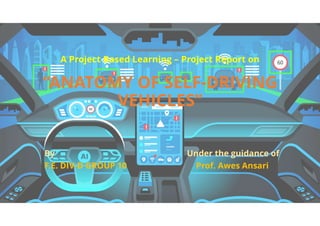
Autonomous driving systems consist of various components that work together to enable a vehicle to operate without human intervention. These components include sensors and perception systems, which gather information about the vehicle's surroundings, as well as data processing and decision-making algorithms, which analyze and interpret this information to make driving decisions. These components are crucial for the safe and efficient operation of autonomous vehicles.
A Sensors and Perception Systems

Sensors and perception systems are integral components of autonomous driving systems. These systems use a combination of cameras, radar, lidar, and other sensors to gather real-time data about the vehicle's surroundings. This data is then processed and analyzed to create a comprehensive understanding of the environment, including detecting and tracking objects, identifying road signs and markings, and anticipating potential hazards. These systems play a crucial role in enabling autonomous vehicles to navigate and make decisions based on their surroundings with accuracy and precision.
B Data Processing and Decision-Making Algorithms

Data processing and decision-making algorithms are critical components of autonomous driving systems. Once the sensors collect real-time data about the vehicle's surroundings, these algorithms process and analyze the information to make informed decisions. Advanced algorithms utilize machine learning and artificial intelligence techniques to interpret the data accurately, detect objects, track their movements, and predict potential hazards. These algorithms play a crucial role in enabling autonomous vehicles to navigate and respond to their environment in a safe and efficient manner.
Levels of Autonomous Driving
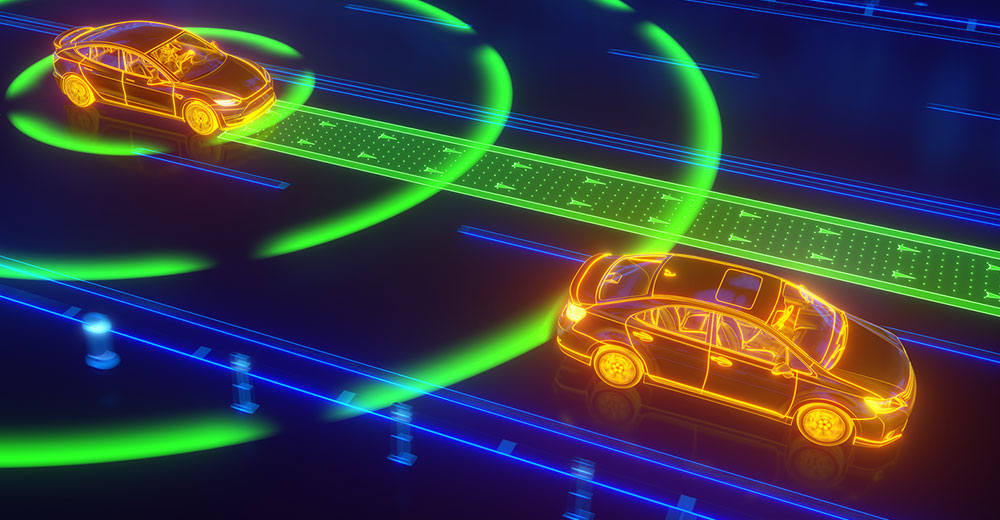
Levels of Autonomous Driving:
The Society of Automotive Engineers (SAE) has defined six levels of autonomy in driving. These levels categorize the level of automation, ranging from no automation (level 0) to full automation (level 5). Each level represents a progression in the vehicle's ability to control itself and interact with its surroundings. As we move up the levels, the reliance on human input decreases, and the vehicle takes on more responsibility for driving tasks. These levels serve as a guideline for understanding the capabilities and limitations of autonomous vehicles.
A Understanding the SAE Autonomous Driving Levels
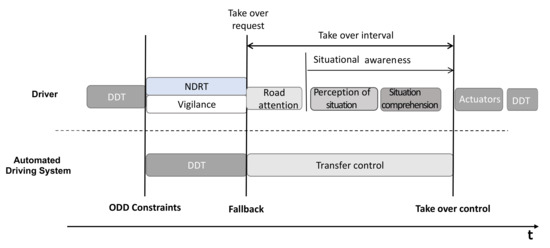
The Society of Automotive Engineers (SAE) has established six levels of autonomy in driving to classify the degree of automation. Each level represents a progression in the vehicle's ability to control itself and interact with the surroundings. These levels range from no automation (Level 0) to full automation (Level 5). It is crucial to understand the SAE levels to comprehend the capabilities and limitations of autonomous vehicles.
B Advantages and Limitations of Each Level

Level 0 of autonomous driving offers no automation, requiring the driver to be fully in control, while Level 1 provides limited automated functions such as adaptive cruise control. Level 2 introduces partial automation with features like lane keeping and automated parking. Level 3 allows conditional automation, where the vehicle can perform most driving tasks, but the driver must be ready to take over when necessary. Level 4 offers high automation, where the vehicle can handle most driving situations, requiring driver intervention only in certain scenarios. Level 5 represents full automation, where the vehicle can operate without any human intervention.
Advantages of each level include improved safety, reduced accidents due to human error, increased efficiency, and enhanced accessibility. However, limitations include the need for human intervention in higher levels, complex decision-making in challenging scenarios, regulatory hurdles, and the potential for system failures. Each level presents unique benefits and challenges, paving the way for incremental advancements towards fully autonomous driving.
Key Technologies in Autonomous Driving
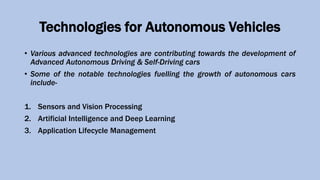
Artificial Intelligence (AI) and Machine Learning (ML) play a crucial role in autonomous driving. AI algorithms enable the vehicle to perceive and interpret the environment through sensor data, while ML algorithms allow the vehicle to continuously learn and improve its decision-making capabilities. Simulations and testing environments are also essential technologies, providing a safe and controlled way to assess the performance of autonomous driving systems in various scenarios. These technologies are driving advancements in autonomous driving and shaping the future of transportation.
A Artificial Intelligence and Machine Learning
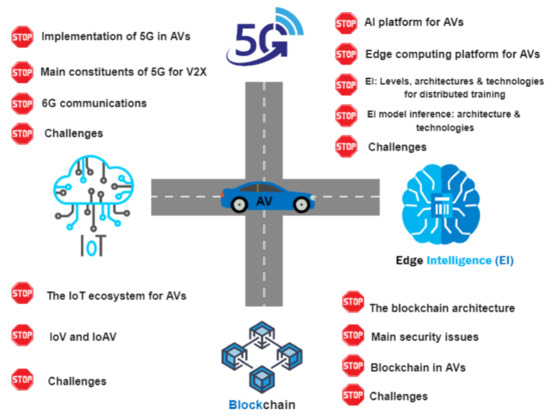
Artificial Intelligence (AI) and Machine Learning (ML) are key technologies in autonomous driving. AI algorithms enable vehicles to perceive and interpret the environment through sensor data, allowing them to detect objects, pedestrians, and obstacles on the road. ML algorithms enable continuous learning and improvement in decision-making capabilities, enabling autonomous vehicles to adapt to different driving conditions and make accurate predictions. These technologies are revolutionizing the field of autonomous driving and paving the way for safer and more efficient transportation systems.
B Simulations and Testing Environments
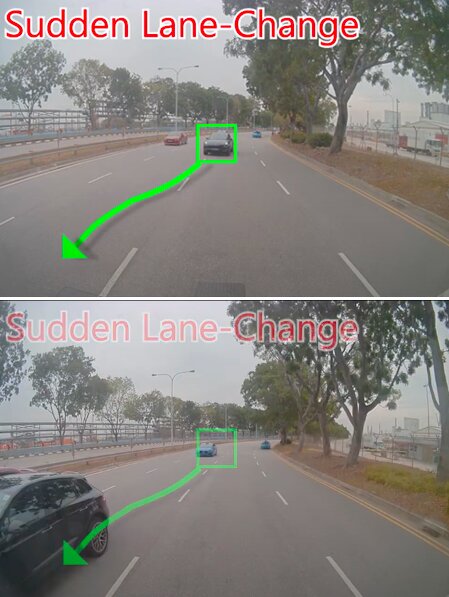
Simulations and testing environments play a vital role in the development and validation of autonomous driving technology. These tools allow developers to create virtual scenarios and test various driving situations without the need for physical prototypes. Simulations provide a safe and cost-effective way to evaluate the performance of autonomous systems, fine-tune algorithms, and train AI models. They also help in identifying and addressing potential risks and vulnerabilities before deploying the technology on real roads. Overall, simulations and testing environments accelerate the development process, reduce costs, and ensure the safety and reliability of autonomous driving systems.
Challenges and Future of Autonomous Driving

The road to fully autonomous driving is not without its challenges. Safety concerns, regulatory frameworks, and public acceptance are key hurdles to overcome. Additionally, the ethical implications of autonomous decision-making and potential job displacement in the transportation industry are pressing concerns. However, the future of autonomous driving holds immense potential. It promises increased road safety, reduced traffic congestion, and improved mobility for individuals who are unable to drive. With continued advancements in technology, collaboration between industry stakeholders, and the development of robust regulations, we can expect a future where autonomous vehicles are an integral part of everyday life.
A Safety and Legal Considerations

Safety and legal considerations are crucial in the development and adoption of autonomous driving technology. Ensuring the safety of passengers, pedestrians, and other vehicles on the road is a top priority. Autonomous vehicles must comply with strict regulations and undergo rigorous testing to minimize the risk of accidents. Additionally, liability and insurance frameworks need to be established to determine responsibility in case of accidents involving autonomous vehicles. Maintaining a balance between innovation and safety is essential for the successful integration of autonomous driving into society.
B Ethical and Social Implications

The development of autonomous driving technology raises important ethical and social implications. One of the main concerns is the decision-making process of self-driving vehicles in ethical dilemmas, such as choosing between protecting the passengers or minimizing harm to pedestrians. There is also a need to address issues related to data privacy and security, as autonomous vehicles collect and analyze large amounts of personal data. Additionally, the introduction of autonomous vehicles may have significant social and economic impacts, including changes in employment and transportation infrastructure. It is crucial to consider these ethical and social implications to ensure a responsible and inclusive integration of autonomous driving technology into our society.
Conclusion

In conclusion, autonomous driving technology has the potential to revolutionize the transportation industry. It offers numerous benefits such as increased safety, improved efficiency, and enhanced mobility. However, there are still significant challenges to overcome, including safety and legal considerations, as well as addressing ethical and social implications. It is crucial to ensure responsible and inclusive integration of autonomous driving technology to fully harness its potential and create a better future for transportation.
A Benefits and Impact of Autonomous Driving

Autonomous driving technology has the potential to bring about significant benefits and impact on transportation. Some of the key advantages include:
- Increased Safety: By eliminating human error, autonomous vehicles have the potential to significantly reduce accidents and fatalities on the road.
- Improved Efficiency: Autonomous vehicles can optimize routes and reduce traffic congestion, leading to improved fuel efficiency and reduced emissions.
- Enhanced Mobility: Autonomous driving technology can provide mobility solutions for people with disabilities or those who are unable to drive, offering them greater independence and freedom of movement.
- Cost Savings: With autonomous vehicles, there is a potential for reduced insurance costs, lower maintenance expenses, and increased productivity due to the ability to work or relax during the commute.
- Real Estate and Urban Development: With the potential for shared autonomous vehicles, the need for parking spaces can be reduced, leading to potential changes in urban planning and development.
Overall, autonomous driving technology has the potential to transform transportation by providing safer, more efficient, and accessible mobility options for individuals and society as a whole.
B Exciting Applications and Potential Future Developments